
-

唱放 PHONO MC-CI
Hi Leo,
Now some more about CI, this time for PHONO, Moving Coil (MC) at a CI input. This explains the name of the B.M.C. Audio Phono Amplifier: PHONO MCCI
這次解釋CI在唱放PHONO MCCI上的應用。
There have been some phono amplfiers in the past with something like a CI input, most times a simple grounded-base-circuit with several transistors in a Faulkner array. In the 1980s I myself had a Threshold SL10, designed by Nelson Pass.
過去有些唱放使用了像CI的輸入,大部份使用多個以Faulkner排列的電晶體,簡單以接地為基礎的線路。在1980年代我自己有Nelson Pass設計的Threshold SL10。
There is a difficulty with this circuit. Please look again at T2 (Picture T2):
With the usual unbalanced RCA connectors the Moving Coil Pickup is connected on one side to ground, and ground is connected to B (Base) of the transistor, whereas the hot signal is connected to E (Emitter). The problem is: Due to the nature of a transistor there is a voltage of about 0.6V between E and B! 0.6V at a very tiny coil may easily burn this coil! The usual solution (as in my old SL10) is to put a capacitor between the MC pickup and E. Working? Yes. Perfect? Far from it! The signal of an MC is a very tiny signal and should be treated with great care. A capacitor not only blocks DC, but some sound quality as well.
這樣的線路是有困難的,請看T2圖:在一般非平衡RCA下,MC唱頭的一邊是接到地,地是接到電晶體的B(Base),正級則是接到E(Emitter)。這樣的問題是,因為電晶體本身的特性,在E與B間存在0.6V的電壓,0.6會讓較小的線圈燒掉,一般解決的方法是在MC唱頭與E間放一個電容,不過這種方式雖然可解決問題,但對聲音不好,MC的訊號非常微小,應該受到很好的照顧,一個電容不僅阻擾了DC,對聲音的影響也一樣。
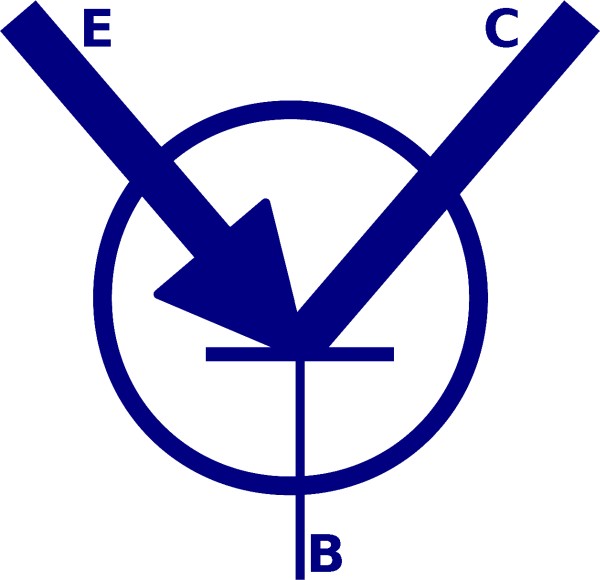
....I'll better make a shortcut to the BMC MC-CI solution:
As a Moving Coil Pickup itself is a perfect balanced and earthfree source, and all our designs are balanced, keeping it balanced is the perfect solution. For some it may need some new wiring or balanced connectors, but that's it.(Picture MC-CI)If the MC is connected with both ends to one and the other E of a balanced CI-input, all problems are gone. This is the perfect solution for Moving Coil Pickups!
我簡單的對BMC MC-CI解決方案說明,當MC唱頭本身是完美平衡與免於接地的來源,包括我們所有的設計是平衡的,那麼保持平衡就是最完美的解決方案。某些也許需要一些新的接線或平衡的端子,請看圖MC-CI
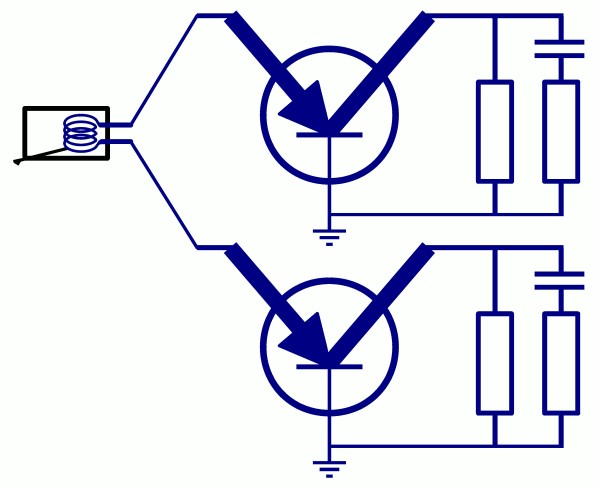
As the impedance (resistance) of an MC is quite low, there is a good chance to get high gain. Let us imagine the MC pickup plus cable plus input resistance of the CI input has a resistance of 5 Ohm. If we use 5 kOhm at the output of the CI stage, we get a gain of 1000. But if you have a High-Output MC pickup with 50 Ohm, gain will be just 100. This means there is some kind of an "automatic" correction of pickups with different output voltages.....Add a resistor-capacitor combination at the output of the CI stage and you can get the first half of the RIAA correction.
當MC的阻抗(電阻)非常低,有一個很好的機會可以得到高的增益。讓我們想像MC唱頭加上線、加上MC輸入的輸入電阻其總共電阻為5 Ohm。如果我們使用5 kOhm在CI輸出級,我們就有1000倍的增益。但如果您有高輸出的MC唱頭是50 Ohm,增益只有100。這意味著存在自動效正不同輸出電壓的唱頭。增加1個電組電容到CI的輸出級,您能得到第1個RIAA修正的1半。
The second gain stage needs making a copy, and the second half of the RIAA at the output ensures a complete correction. The final output stage is a small LEF buffer for driving cables and the following input. Thus there are only 2 copies made in the PHONO MCCI.
第2個增益需要1個COPY(訊號),以及在輸出的第2個1半的RIAA確保了完整的修正。最後的輸出級是一個小的LEF緩衝來驅動線材與輸入。因此總共只有2次的COPY在PHONO MCCI中。
CI has one more advantage for PHONO MC: As the current of the MC flows into the CI input, there is a natural damping of the electro-mechanical system. If you use a usual voltage input (Picture T1) there is nearly no current flowing into B - and the moving parts keep oscillating. That's why usual phono inputs have resistors for finetuning the damping. But it is always a compromize: The lower the resistor, the better the damping - but: The energy is distroyed in the resistor - and it really sounds like lost energy. CI makes use of the energy, and thus it sounds like energy.
CI還有一個對PHONO MC的優點,當MC電流進入CI輸入級,有1個電磁系統的天然阻尼存在。如果你使用一般的電壓輸入 (如圖T1),將近沒有任何電流會進到B,移動的部分會持續擺動。這也是為什麼一般的唱放書入有電組來調整阻尼。不過這樣總是是妥協的作法,較低的電阻,越好的阻尼,但能量會在電阻中遭到破壞,聽起來會沒能量。CI則是使用能量、聽起來有能量。
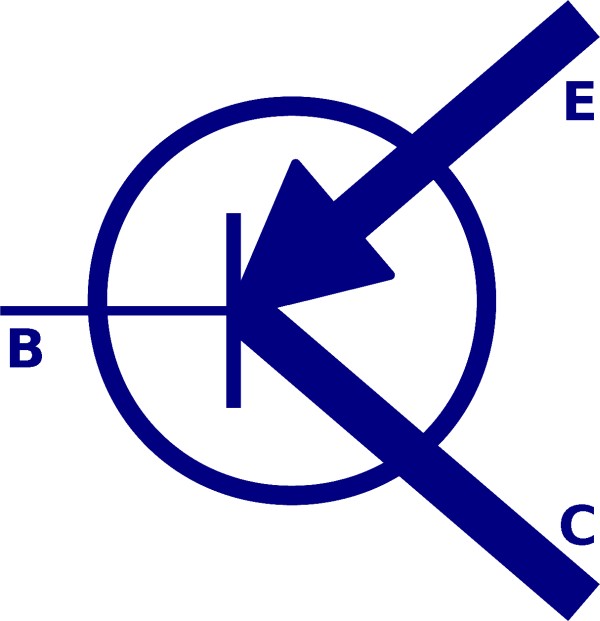
A last hint for using B.M.C Audio PHONO MCCI: This Unit is working with almost all available Moving Coil pickups, even the ones designed for stepup-transformer use. The best dynamic performance is to be expected if a strong magnetic circuit is used and the impedance is low (recommended: under 10 Ohm).
最後一個使用B.M.C Phono MCCI的重點,其可對應使用大部份的MC唱頭,甚至是需要升壓器的唱頭。如果有夠強的磁力線路與低阻抗(建議低於10 Ohm),那麼會有最佳的動態表現
Best Regards,
Michael




-
-

這兩句要重翻一下:
”Add a resistor-capacitor combination at the output of the CI stage and you can get the first half of the RIAA correction.” 在CI級的輸出加個電阻電容,你就完成了RIAA等化的前一半的工作。
“The second gain stage needs making a copy, and the second half of the RIAA at the output ensures a complete correction.” 第二個增益級需要複製訊號,在它的輸出端加上RIAA等化的另一半的線路,RIAA等化就作完了。
我個人一直認為,唱放應該要作成全平衡的放大(像BMC或是AQVOX的Phono 2 Ci),因為唱頭輸出的訊號本來就是全平衡的。看來我得存點錢來支持BMC的產品(美國有賣嗎?)
-
The Following User Says Thank You to kevintran For This Useful Post:
-
-
-

 作者: 小葉

請洽aa importer
這樣會找不到的...
是Aaudio Imports
-
-
-
-

最少的訊號COPY
Dear Leo,
This time I like to write about reducing the process of "making copies“ to the minimum. And it is related of how to connect the B.M.C. units.
這次我要解釋B.M.C的設備是要減少COPY訊號的數量到最小,這同時也是對B.M.C.器材間如何相連的解釋。
Translation may be difficult. After reading your translations to Chinese, I can see that "copy“ is not translated. I could not find an online translation with the exact same meaning. What do you think: Is it better to use "generation“ instead of 'copy“? Means: If you make a copy of the original signal, you get the second generation of the original signal.
翻譯或許很困難,我看到你並沒有翻COPY,或者是用"generation"這個詞比較好,如果你COPY原來的訊號,那麼你就會得到原來訊號的第2代。
PS 其實我沒翻COPY主要有兩個原因,第1個是因為大概所有人都懂COPY這個英文的意思,第2是保留COPY比較不會因為翻譯造成原文許多精神遺失
As I explained before: There are copies of the input signal needed, in case you need more current at the output as you can get at the input. As a Moving-Coil pickup or a DAC-Chip does not deliver enough current for driving speakers, there is at least one copy required. Means: In the best case you listen to the second generation.
如同我解釋過的,當你輸出需要比輸入更多的電流時,就存在COPY輸入訊號的需要。當MC唱頭或DAC晶片沒提供足夠的電流驅動喇叭,那麼就只少要COPY一次,也就是說你聽到的是第2代的訊號了。
Our units are intended for using the fewest possible copy processes. But they should be compatible in a setup with other units as well. Our DAC1PRE should be working with active speakers as well as with other power amplifiers, and our power amplifiers should work with other preamps as well. In case you use DAC1PRE and AMP S1 or M1 as a set, there is a shortcut, avoiding some copy stages, or generations.
B.M.C 要使用最少的COPY過程,但是他們要能與其他器材相容,如DAC1PRE要能與主動式喇叭或是後級搭配,B.M.C的後級也要能與其他品牌的前級搭配,如果您使用AC1PRE與AMP S1或M1搭配,就不會有任何的COPY或Generations產生。
First let's have a look at a traditional setup with B.M.C. components:
先來看看B.M.C傳統的設置方法
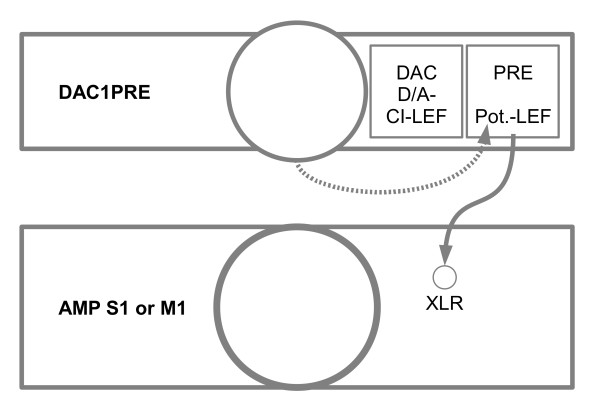
This looks pretty "business as usual“: There is a DAC with integrated Preamp and a volume control, connected to a power amplifier. If you turn the volume knob, the signal is attenuated by a potentiometer, and the power amplifier has the usual fixed gain. In this combination you can exchange AMP S1 or M1 to a different power amplifier, or as well exchange DAC1PRE to a different DAC and a preamp – still working. This kind of setup should be familiar for every HiFi user.
這個圖與一般系統的連接情況差不多,就是有音量前級的DAC然後連接到後級,如果轉音量,那訊號就會隨電位計調整,後級的增益是固定的,在這樣的組合下,您可以將AMP S1或M1換成不一樣的後級,或是將DAC1PRE換成不同的DAC與前級。
But: Let us have a look at the copy stages: First there is the DAC section with the D/A-converter, a CI-I/V-converter (no copy) and the LEF buffer (one copy). This signal is attenuated by the potentiometer and buffered by the LEF output stage (one copy). The output signal goes to the XLR input of the AMP S1/M1, amplified (one copy) with a fixed gain to the output voltage, and finally the LEF buffer (one copy) adds the required current for driving the speakers. That's a total of four copies. Or: At the output you get the fifth generation of the input signal.
不過我們來看COPY的部份,首先DAC有D/A轉換、CI-I/V轉換(No Copy)與LEF緩衝(one copy),訊號隨電位計調整,且由LEF輸出級(one copy)所緩衝。輸出訊號到AMP S1/M1的XLR輸入,以固定的增益放大(one copy)到輸出的電壓,也就是輸出是輸入的第5代的訊號了。
Still not bad if compared to most designs, needing five to ten copies in the DAC, another five to ten copies in the preamp and another at least four copies in the power amplifier (differential stage, voltage gain – needed for feedback loop, driver stage plus output stage), a total of fourteen to over twenty copies. Or: You listen to the fifteenth (or more) generation.
與大部份DAC的設計相比,需要5~10次COPY已經好多了,前級一般要5~10次COPY,後級要至少4次的COPY (動差級、電壓增益、迴授、驅動級與輸出級),一共有14~20次的COPY,您聽到的是第15代或更多Gereration的訊號。
But we can do even shorter (= better). Let's have a look at the short signal path our B.M.C. chain is intended for:
但我們可以讓這個更短 (=更好),讓我們看看B.M.C最短的路徑
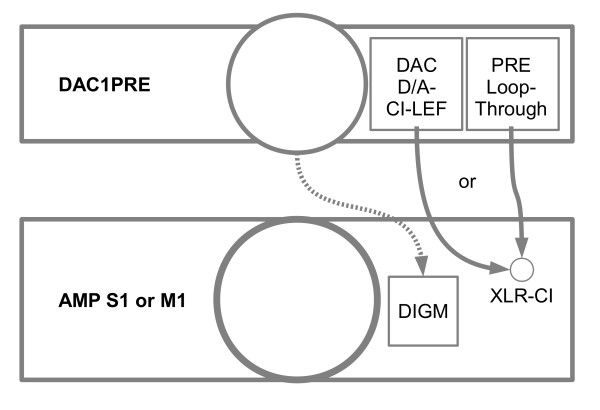
In this setup the preamp section of DAC1PRE is configured by an internal jumper setting to loop-through mode, means the signal of the DAC section (as well as the analogue XLR input) is just routed to the output. (The unbalanced RCA input needs an extra stage to get a balanced signal.) For all digital inputs it means: The music signal is same as at the fixed output of the DAC section. Volume control doesn't do anything to the music signal inside of DAC1PRE. This means: The unattenuated signal is connected to the XLR-CI input of the AMP S1 or M1. The volume control of the DAC1PRE just generates a digital word, transmitted by an optical waveguide to AMP S1 or M1, where the gain is adjusted (DIGM) according to the digital word. And for the user's information we display the DIGM setting in the window.
在這樣的設置下,DAC1PRE前級部份從內部的跳線設定為loop-through模式,意味著DAC的訊號(XLR類比輸入也是)是傳到輸出。(非平衡輸入確實需要額外的輸入來得到平衡的訊號)。對所有的數位輸入意味著:音樂訊號在DAC固定輸出是一樣的,在DAC1PRE音量對音樂訊號並沒有做了什麼,這意味著,訊號連到AMP S1或M1的XLR-CI輸入時並未改變(no copy),在DAC1PRE的音量只有產生數位語言,將光學波導傳到AMP S1或M1,在這其增益是依數位語言來調整的(DIGM),我們在後級的表頭會顯示DIGM的設定。
Once set up this way, there is no handling difference compared to the traditional connection.Let's have a look at the copy stages again: First there is the DAC section with the D/A-converter, a CI-I/V-converter (no
copy) and the LEF buffer (one copy), available at the output of the DAC module, and this signal is routed to the preamp output as well. The output signal is connected to the XLR-CI input (no copy) of the AMP S1/M1, amplified with adjustable gain (DIGM) to the output voltage, and finally the LEF buffer (one copy) adds the required current for driving the speakers. That's a total of only two copies! Or: At the output you get the third generation of the input signal.
我們近一步看COPY的部份,首先在DAC有D/A、CI-I/V-converter (no copy)、LEF buffer (one copy),輸出訊號連到AMP S1/M1的XLR-CI (no
copy),使用DIGM調整增益到輸出電壓,最後LEF buffer (one copy)增加驅動喇叭所需的電流。
The above explanation is about digital sources.
以上是對數位部份的解釋。
Let's have a look at a B.M.C. chain with the PHONO MCCI involved: PHONO MCCI has a CI input (no copy), a second gain stage (one copy) and an output LEF buffer (one copy). In a traditional setup with B.M.C. components this means: PHONO MCCI: two copies, Preamp of DAC1PRE: one Copy, AMP S1 or M1: two copies. A total of five copies (means listening to the sixth generation) – still not bad for the tiny signal of a moving coil pickup amplified to drive speakers.
若是PHONO MCCI有CI輸入(no copy)、第2個增益級 (one copy)與 output LEF buffer (one copy)。在B.M.C傳統的設置下意味著,PHONO MCCI:有兩個COPY,DAC1PRE的前級 (one copy)、AMP S1或M1(two copies),總共有5個copies (意味第6代訊號),依然對微小訊號去擴大驅動喇叭不是太差。
The B.M.C. shortcut with DIGM means: PHONO MCCI: two copies, DAC1PRE: No copy because of Loop-Through, DAC1PRE volume control
sets the DIGM inside of the power amp, AMP S1 or M1: No copy at CI input, one copy in the final LEF stage. That's a total of just three copies (means listening to the fourth generation) from PHONO MC to the speakers!
B.M.C的DIGM則是捷徑: PHONO MCCI: two copies、DAC1PRE:無,沒有COPY是因為Loop-through、DAC1PRE音量控制設定了在擴大機裡的DIGM,AMP S1或M1:在CI 輸入這段是沒有COPY的,有一個COPY是在最後的LEF級發生,總共就只有3次COPY。 (也就是從Phono到喇叭是聽到第4代訊號)
That's the general description of how we look at the signal path, and why we like to keep it short. What counts in the end is the listening experience of the music reproduction. Sure, even one of our units in an existing HiFi setup may provide some new listening experience. But may be you got the idea: If you use one of our units, making only two copies (or two more
generations), in a chain with already ten copies (or ten generations), it may make a difference, but it is far from how we intend music to be experienced. If you like to get an idea about how we like music to be reproduced, try our "shortcut“ B.M.C. chain, using the CI input.
這是我們對訊號路徑的基本解釋,為什麼我們喜歡讓他越短越好,最後就是反應在音樂的再生。當然,任何一台B.M.C的器材都能有一些新的聆聽體驗,但當您使用一台我們的器材 (只有2個COPY) 到1個已有10個COPY的系統中,雖然會不一樣,但跟我們想要表達的音樂再生體驗有落差,如果您要體驗B.M.C的器材聲音,那就是使用CI輸入。
Best regards,
Michael
-
-

老字号 新品牌---B•M•C Audio 2012-06-12 11:42:46 ---采访B.M.C Audio推广经理Mr·Michael Conrad http://www.3dsound.cn/news/17681465.html 老字號 新品牌---B•M•C Audio ---採訪B.M.C Audio推廣經理Mr·Michael Conrad B.M.C Audio,一個來自德國的新品牌,雖品牌很新,但旗下產品從CD轉盤到大功率後級,一應俱全,外觀造型新穎別緻,個性十足。對於B.M.C Audio,我也是早有耳聞,並在多個場合充分感受過它的魅力,但一直沒有機會真正做到較為詳細的了解,直到這次來到2012年SIAV20年上海音響大展才知這個在中國還並未人所熟知的德國品牌實際已有20多年的發展歷史了,且擁有多項獨家專利。 B.M.C Audio,對於中國的很多人來說還很陌生,20多年來它一直堅持為很多國際音響客戶做設計方案,直到2001年將公司從德國遷移至中國大陸才開始了OEM與ODM的生產,主要客戶群是日本音響品牌,而唱機中的名家CEC就是由他們代工完成的。據說B.M.C Audio的創辦人也是業內頗具影響力的人物,1975年成立的德國Restek(力無敵)既是他的傑作。 B.M.C Audio推廣經理Mr.Michael.Conrad在接受筆者採訪時這樣告訴我,B.M.C Audio當下最有名的可算是他家的唱機,而這一切皆因他們與CEC千絲萬縷的聯繫。他家的創辦人之一Carlos從學校畢業就在柏林自己開公司為很多音響公司做專案設計,主要客戶就是日本CEC,我們現下知道的許多膾炙人口的CEC頂級音響,都是出自他手,如重量級的CD轉盤TL-1與TL-2,及後來相當暢銷的TL-5100 CD唱盤。而這些唱盤最大的特點就在於都採用了“皮帶驅動”,有別於一般唱盤的機械驅動。其實對於“皮帶驅動”,若各位對黑膠唱盤有一定了解的話,就知道這是唱盤的設計主流,但當時間進入數字唱機時代,則全部換成了直驅馬達,原因是黑膠LP轉速恆定,利用皮帶驅動可以降低馬達震動的負面影響,但數字唱機的轉速隨時都在變化,皮帶驅動很難做,於是所有的數字唱機和轉盤全部改成了馬達直接驅動,如此才能精確控制轉速的變動,而CEC利用獨創的轉速伺服系統控制,可以精確控制變動的轉速,同時擁有皮帶驅動降低震動影響的好處,在當年的音響市場可說是風投佔盡,風靡全球市場,宣稱是最有LP味的CD轉盤。在與Mr.Michael.Conrad的交談中他告訴我目前他們在中國大陸的公司仍保持著與很多世界音響公司的合作,仍以OEM/ODM為主,但自主品牌B.M.C Audio也已開始逐漸成為公司主力。 關於B.M.C Audio,其實很多人都不了解,雖然筆者之前也有過多次聆聽,但對其歷史卻是知之甚少,在這次與B.M.C Audio推廣經理Mr.Michael.Conrad的採訪中就特意對B.M.C Audio進行了一番了解。 B.M.C Audio推廣經理Mr.Michael.Conrad告訴我他們之所以選擇在德國設立公司,為的是技術本位,旗下產品是希望大家都願意也能夠購買的音響,且無論是性能還是操控上B.M.C Audio都絕不輸於諸多世界Hi-End音響,其價格卻是較為合理。 Mr.Michael.Conrad告訴我B.M.C Audio其實早在2009年便於德國上市,且有著較高評價,2010年正式參加德國慕尼黑音響展,進軍全國市場。很快它合理的市場價格和技術本位的內容讓B.M.C Audio在市場上得到最好的回報,讓太多的消費者燃起了換機、購機的慾望。 那麼B.M.C Audio的聲音特色是如何呢? Mr.Michael.Conrad告訴我,B.M.C Audio對於聲音整體設計追求的是絕對的均衡(balance),這種均衡不僅講究線路,還包括聲音的價值均衡。如他們為音響專門訂製的電容,規格上要求其充電與放電速度要一樣快。而且B.M.C Audio的產品外觀設計有著完全相同的設計元素,從唱機到功放無一改變,讓人一看就知道是來自於同家公司。他家正面特大號的表頭和居中特大號的旋轉掣,漂亮的銀/黑雙色機箱,這些都是B.M.C Audio的產品特徵。 現場Mr.Michael.Conrad不光為筆者講述了B.M.C Audio公司,更多的還為我們講了很多技術性東西,譬如利用雙同軸電纜的Super-Link數字傳輸技術、皮帶驅動數字唱機或轉盤、增益控制、電流注入(Current Injection,簡稱CI)……等等,都是非常技術的東西。如B.M.C Audio與眾不同的設計理論中的音量控制設計,所謂的CI技術可以免除了傳統可變電阻的訊息損耗,另外LEF技術可將電流與電壓做分開處理,完全不需要傳統的負迴路設計,如此就能讓功放擁有非常線性的工作輸出。 今天我們看到的這個B.M.C Audio雖然是音響界新星,誕生並不久,但卻是集結了諸多音響前輩,旗下很快就面向市場推出眾多型號產品,各系列齊全,可見是有備而來,相信在不久的將來B.M.C Audio一定能以高品質的德國設計加上優質的中國製造擄獲世界各地消費者的心。 
-
The Following User Says Thank You to boxoo For This Useful Post:
 發文規則
發文規則
- 您不可以發表新主題
- 您不可以發表回覆
- 您不可以上傳附件
- 您不可以編輯自己的文章
-
討論區規則
|















